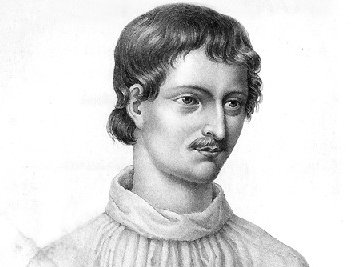
In the early morning light, on the day after Ash Wednesday, the primary day in the Church calendar for Christian penance, Giordano Bruno, one of the most original minds of the sixteenth century, rode into Rome's Campo de' Fiori on a mule. Stripped naked and gagged with a leather bridle to prevent him from shouting out heresies to those present in the plaza, Bruno mounted the pile of firewood, charcoal, kindling, and pitch. Tied to the stake, Bruno turned his head away in anger when a crucifix was held up to his face. The pyre was lit and the flames leaped to consume the heretic.
The Church records for that morning, February 17, 1600, reported the basic facts: Bruno "was led by officers of the law to Campo de' Fiori, and there, stripped naked and tied to the stake, he was burned alive, always accompanied by our company singing the litanies, and the comforters, up to the last, urging him to abandon his obstinacy, with which he ended his miserable and unhappy life."
Eight days earlier, when he received his death sentence from his inquisitors in The Holy Office, Bruno told them, in what was described as "a menacing tone," "You may be more afraid to bring that sentence against me than I am to accept it." Bruno had shared his knowledge and ideas in Protestant countries for years, sometimes with kings, ambassadors, and dukes, so Rome had some reason to worry that Bruno's execution might have political repercussions. The execution also represented a failure of the Roman Inquisition to perform its self-described mission, which was less to terrify through public executions than to "admonish and persuade." The burning of Giordano Bruno would haunt the man most responsible for his execution, Cardinal Robert Bellarmine (who was awarded in 1930 with sainthood), and almost certainly influenced how Bellarmine would choose to proceed against another obstinate heretic, Galileo, two decades later.
Today, Giordano Bruno is widely seen as a martyr to the cause of free speech. A large statue of Bruno rises in Campo de' Fiori. Bronze letters on the granite pedestal proclaim, "To Bruno, from the generation he foresaw here, where the pyre burned." Every February 17, the mayor of Rome lays a wreath, draped in red and gold ribbons, at Bruno's feet. Yet there remains confusion over exactly what speech it was that convinced his inquisitors that only burning him alive would solve the Bruno problem.
The Life and Thought of Giordano Bruno
In 1548, Giovanni Bruno and his wife, Fraulissa Savolino, saw the birth of their only child in a farmhouse near the small settlement of Nola, Italy. They named their boy Filippo. At age fourteen, lonely but precocious, Filippo traveled the thirty miles west to Naples, then the fifth largest city in the world. While little is known about what Filippo did do earn money in those early years in the big city, it is clear that he developed survival skills and spent a great deal of time reading, studying, training his memory, and thinking. By 1565, Bruno had entered into the monastery of San Domenico Maggiore, a center of resistance to Spanish rule, a conservative institution favored by nobility, and an excellent place from which to begin to link theological and political ideas. San Domenico taught Scholastic philosophy--the ideas of Aristotle as reconsidered by St. Thomas Aquinas and other scholars. It was a philosophy newly challenged by a revival of Plato's more poetic ideas about the world. Encountering Neoplatonism, Bruno began to develop his own, highly original, philosophy.
Evidence suggests that Bruno's non-conformist thinking was a concern to officials. Bruno removed from the walls of his cell at the monastery pictures of the Virgin Mary and other religious decorations, save a single crucifix. He read and made margin notes in Erasmus's proscribed book, "Paraphrases of the New Testament." (The book was discovered by officials in a latrine that Bruno used.) Privately, Bruno began to have doubts that Jesus was the Son of God incarnate in human flesh, a central teaching of the Catholic Church. Nonetheless, it was clear to all that Bruno was a brilliant student. Using "artificial memory" techniques first developed in Ancient Greece and Rome (techniques that link words or phrases to vivid images), Bruno developed the reputation as a man possessing a marvelous, almost unbelievable, memory. In 1569, Bruno was sent to Rome to perform feats of memory before Pope Pius V.
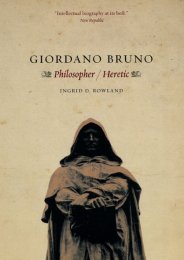
By age twenty-four, Bruno became a priest and gained admission as a formal student in theology at the prestigious College attached to San Domenico Maggiore in Naples, a college which Thomas Aquinas, in the thirteenth century, taught briefly as a professor near the end of his career. Three years into his training, Bruno was informed that he was under investigation by the Inquisition. The basis for the investigation is not completely clear, but according to Ingrid Rowland, in her book Giordano Bruno: Philosopher/Heretic, the main charge was likely his defense of certain early Christian heretics who had suggested that Christ was not fully divine. Shortly after learning of the proceedings, he left Naples and headed first to Rome and the convent of Santa Maria Sopra Minerva. After a brief stay in Rome, he shed the garments of a friar and traveled as the Filippo Bruno, gentleman, north to Genoa, then on to the seaside village of Noli, where he landed a job teaching grammar to children.
For the next fifteen years, Bruno would frequently be on the road, traveling from one European city to the next, never staying more than three years in any one city. Wherever he went, he wrote and sought jobs teaching philosophy. He moved first to Venice, with short stays along the way in Savona and Turin. In Venice he published a booklet, The Signs of the Times, and then hit the road in 1577 for Geneva, the intellectual and spiritual center of Calvinism. In Geneva, Bruno converted to Protestantism and enrolled at the University of Geneva as "Phillipus Brunus Nolanus, professor of sacred theology." While at the university, he published a broadsheet attacking the ideas of a philosophy a senior teacher, Antoine de La Faye. As a result, Bruno was arrested and spends two-plus weeks in jail, before apologizing on his knees to the professor. Bruno always seemed to have a knack for getting into trouble.
Bruno left Geneva and headed to Lyon, and then Toulouse, France, where he lectured for two years at the University of Toulouse on Aristotle's On the Soul. Next, it was on to Paris, where he published a book about memorization techniques, On the Shadows of Ideas. Intrigued by the techniques, King Henri III made Bruno his private tutor, as well as professor and royal reader, instructing in the art of memorization, logic, and metaphysics. While enjoying the good life in Paris, Bruno published a black comedic play about Neapolitan life called The Candlemaker.
With rumors in the air of the Inquisition coming to France, Bruno moved to England, where he found, in a theology debate at Oxford, that many people laughed at him because of his odd gestures, physical appearance, and accent. Bruno took the insults seriously, and forever after hated the English, saying "They look down their noses, laugh at you, [and] fart at you with their lips."
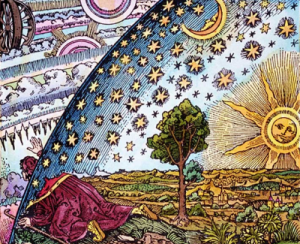
While in England, however, Bruno further developed ideas about the universe that marked him as an original thinker, ideas far beyond his Oxford lectures arguing that the Copernican system offered support for a version of Platonic theology. After leaving Oxford for London, Bruno published a dialogue, The Ash Wednesday Supper, in which he suggested a larger universe than Copernicus imagined, one with millions of inhabited planets circling millions of suns. In subsequent dialogues (over his lifetime, Bruno produced thirty works), he argued that awareness of a vast, inhabited, and infinitely old universe will (and should) transform human lives. Coupled with his views about the infinite universe, Bruno pushed his atomic theory, which held that everything was made up of identical particles (in Bruno's terminology, "seeds") in which God, with his informing love, resided. Thus, Bruno produced a new philosophy, outside the scope of previous Western thought, that brought together ideas about the unimaginably large and the unimaginably small, unified by a belief in an omnipresent, loving God.
It is almost impossible to overstate how mind-blowing thise ideads must have seemed at the time. Even though his ideas owed relatively little to empirical observation or mathematics, Bruno's natural philosophy comes closer to our modern understanding of the cosmos than any other thinker of the sixteenth or seventeenth centuries.
After England, there would be seven more years of moves around the map of northern Europe. In 1585, Bruno's friend and patron in London, French Ambassador Castlenau, was recalled to Paris, leaving Bruno little choice but to follow him to a Paris that was edging towards a religious war. By the next year, with signs of war continuing to mount, Bruno fled to Germany, where he lectured at the University of Wittenberg, the very town where Martin Luther hd launched the Reformation. Then in 1588 it was on to Prague, and then to the Lutheran University of Helmstedt. With fights breaking out at Helmstedt between Calvinist and Lutheran faction, Bruno decided to move to Frankfurt-am-Main, where he published two more works developing his philosophy.
The picture of Giordano Bruno that emerges is that of a committed maverick and a bit of a misfit, a man who despised the mindless acceptance of traditional teaching. In that sense, as his biographer Michael White noted, was "all embracing." He believed in the right of every person to think as they wish. Reason, not orthodoxy, was Bruno's guiding star. First, "doubt all things" is the advice he had for philosophers.
A Bad Move
While Bruno was in Frankfort, a wealthy Venetian gentleman, Giovanni Mocenigo, read several of Bruno's writings, was impressed by them, and invited Bruno to come to Venice, stay in his residence, and tutor him. In what would ultimately prove to be a fatal decision, Bruno decided to take up his offer. He must have understood the risk he was taking. But after twenty years of exile, we might imagine Bruno homesick, longing to hear his native tongue, and anxious to see again the places of his youth.
In 1592, he moved to Venice and took up residence in Mocenigo's home. Mocenigo, however, over time came to believe that Bruno held heretical beliefs. (He also seemed to believe that Bruno was withholding from him knowledge of some of his most effective memory tricks--and might have been concerned that Bruno was too attracted to his wife.) He disclosed his concerns about Bruno to his father confessor, who urged him to denounce him to The Holy Office. When Bruno, on May 22, becoming uncomfortable with his situation, announced his intention to return to Germany, Mocenigo (in Bruno's own words) ordered "five or six" servants to "lift me out of my bed and carry me to the attic" of his palazzo. Locked in the attic, Bruno was told by Mocenigo that unless he revealed his secrets for memorizing words "something unpleasant would happen" to him. Bruno, in his account, replied "I had taught him enough and more than I was obliged to, and that I did not deserve to be treated like this." The next day, Mocenigo reported Bruno to civil authorities, who in turn delivered him to the Inquisition.
Mocenigo, in a three-page letter to the Inquisition made a long series of accusations against Bruno. In his letter, Mocenigo claimed to have heard Bruno say, "while conversing in my home, that it is a great blasphemy for the Catholics to say that bread transmutes the flesh, that he is an enemy of the Mass, and that Christ is a wretch." The letter, written in the shaky hand of an infuriated man, also claimed Bruno "revealed plans to make himself the head of a new sect under the name of a new philosophy, that the Virgin could not have given birth, ...that our Catholic opinions are the teaching of asses,...and that he marvels that God can bear such heresies of Catholics." The letter ends: "And I reverently kiss the hand of your Reverend Paternity. At home, May 23, 1592."
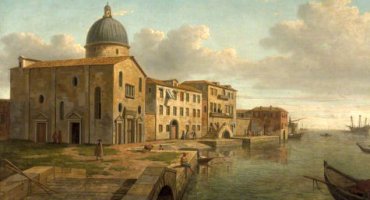
Bruno was interrogated in jail and deposed six times by three judges in the chamber of the Ducal Palace in the complex of San Domenico di Castello. While confined, Bruno cursed God and bickered with some of the five other prisoners who shared his cell. One of his fellow prisoners, a friar with a history of mental instability named Celestino Arrigoni, would later report to inquisitors that Bruno woke up one night cursing God ("Traitor! Take that, wretched . . .cuckold! Look how you run the world!") and gave the finger to Heaven. During one theological argument between the two men, Bruno allegedly slapped friar Celestino.
Mocenigo identified three witnesses, including two booksellers and a nobleman, who might support his charges against Bruno. All three men were summoned to appear before the Inquisition, but none of them offered much support for the case against Bruno. One bookshop owner testified that Bruno was "a little skinny man with a bit of a black beard" who, to his knowledge, "has never said anything to make me think he was not a Catholic and a good Christian." Another said that Bruno "spent most of his time writing and going around talking riddles and astrologizing new things." He noted that "he read heretical teachers," but seemed to be "a good Christian." In his own depositions, Bruno admitted to having doubts about some tenets of the Catholicism, but denied that he either held or advocated heretical positions. Bruno's admission on June 2 that he had ever since he was a young friar "harbored doubts" about whether Jesus was the Son of God seems to have been the statement that most bothered his inquisitors and might well have been their main reason for keeping him in prison even after, at his final deposition, on July 30, 1592, Bruno retracted the beliefs and positions attributed to him in Mocenigo's original letter to the Inquisition. On his knees before the three judges, Bruno said, "I humbly beg pardon of the Lord God and your illustrious Lordships for all the errors I have committed, and am ready to carry out whatever your prudence shall have deliberated and judged expedient to my soul....I promise to make a notable reform of my life, and repay every scandal with edification."
While in his cell in Venice, awaiting a decision by Venetian authorities on a request by Rome for his extradition to that city, Bruno managed to strengthen the case against him. According to one of his cellmates, Bruno got into a "huge argument" with two fellow prisoners (both friars) about whether Christ's statement (as reported in the Bible) on the cross, "Father, let this cup pass me by," proved that Jesus was mortal. Bruno contended that it did.
Bruno's Trial in Rome
It took months to make an extradition decision, but in the end--for complicated political reasons--Venetian authorities, in February 1593, loaded Bruno on a ship bound for the prisons of the Roman Inquisition. For the final seven years of his life, Bruno would live in a private cell located just south of St. Peter's Square. Bruno's problems escalated in the fall when Rome received from his former cellmate in Venice, Friar Celestino, listing thirteen of Bruno's statements and actions in prison which the friar believed to be heretical. The charges ranged from his cosmology (Bruno believes "that there are many worlds, and all the stars are worlds, and believing that this is the only world is extreme ignorance") to his comments about Biblical stories ("Moses only pretended to talk to God on Mount Sinai, and that the law he gave to the Hebrew people was made up by himself") to his future intentions ("He wanted to return to Germany or England among the heretics where he could live in his own way and more plant new and infinite heresies there"). Celestino's letter prompted Roman officials to hunt down all of Bruno's former cellmates and interrogate them, and their answers, in large part, confirmed Celestino's allegations.
Examining transcripts from the proceeding against Bruno in Venice, Roman inquisitors noted the frequency of references to Bruno's numerous writings. Over a strikingly long period of time, roughly the next six years, officials struggled to prepare a complete list of Bruno's writings and to track down surviving copies in whatever parts of Europe they might be found. Bruno, meanwhile, used his time in prison to draft his defense.
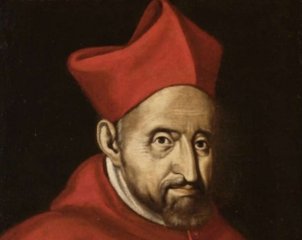
In 1599, Jesuit theologian Robert Bellarmine, who had served as a consultant to the Inquisition since 1592, was made a cardinal by Pope Clement VIII. With his red hat, Bellarmine could be appointed directly to the Board of Inquisition, and he used his new power and incisive mind to turn the screws on Giordano Bruno. Bellarmine began by reducing the long list of Bruno's possible heresies to eight propositions, each of which Bruno would have to abjure if he were to save his life. The actual record of the eight proposition has been lost, but the Church's summary of Bruno's trial provides several clues. The summary indicates that there were four general subjects of concern on which Bruno refused to budge, specifically his beliefs about (1) the Trinity, divinity, and incarnation, (2) the existence of multiple worlds, (3) the souls of humans and animals, and (4) the art of divination. Bruno's opinions on all these matters, as well as his contention that "the sin of the flesh" was not a mortal sin, seem to have been the central focus of Bellarmine's questioning.
Bruno responded to Bellarmine's insistent questioning of his most stubbornly held beliefs by demanding that Bellarmine prove that the pope considered each of eight propositions to be "definitely heretical." Bruno indicated that if Bellarmine could provide such proof, he would consider abjuring his positions. Bellarmine, however, undoubtedly considered Bruno's demand to be an insolent challenge to his authority, and the demand for papal intervention certainly did not help Bruno's case. Nor, to be sure, did Bruno's final retort to Bellarmine after a series of escalating insults: "You lie through your throat." Frustrated by his intransigence, Bruno's inquisitors debated subjecting Bruno to torture, although historical records do not answer the question of whether it was actually inflicted. At the least, Bruno must have been aware of the threat, and for many prisoners, the threat alone might be enough to produce a retraction. But not for Bruno. Ingrid Rowland, in her biography of Bruno, writes that by this point, "In his own way, in his own terms, Giordano Bruno now began to prepare for his own martyrdom."
Bruno, forced to kneel before his inquisitors, heard his sentence imposed: "We...declare you, the aforementioned Fra Giordano Bruno, to be an impenitent, pertinacious, and obstinate heretic....We now expel you from our ecclesiastical bar and from our holy and immaculate Church, of whose mercy you have now rendered yourself unworthy." Bruno replied, "You may be more afraid to bring that sentence against me than I am to accept it."
It took some time for the Inquisition to decide to burn Bruno at the stake, as they weighed the political risk of offending some of Bruno's powerful friends around Europe. But decide they finally did. On February 8, 1600, Church officials performed "a solemn degradation," a ceremony in which Bruno was stripped of his symbols of the priesthood, his deacon's stole, his sub-deacon's alb and maniple, his acolyte's candle, his Dominican scapular, and his habit. Then he was shaved, dressed in the clothes of a layman, and turned over to a bailiff representing the secular arm of the Roman government, for transport to the prison of Tordi Nona. For the next eight days, various friars make appeals to Bruno to repent, before the end came in Campo di Fiori on February 17, 1600.
Did it really have to end at a stake in Rome? After all, Bruno had killed no one, led no insurrections, stolen nothing. He even had complied with the terms of his excommunication. His crime, if it was one, was to write and argue. Bruno was killed because of his ideas--ideas that were original, thoughtful, and beautiful, but inconsistent with those of the Church. Bruno burned because Cardinal Bellarmine concluded there was no way of bringing this brilliant and stubborn man into line. And, in the year 1600, maintaining lines is what the Church did.